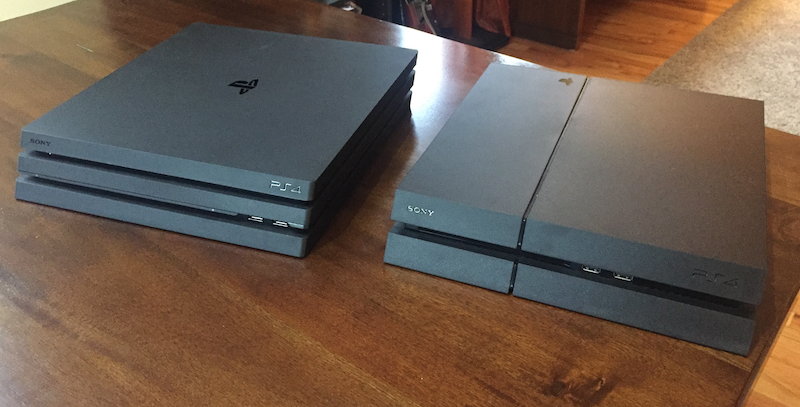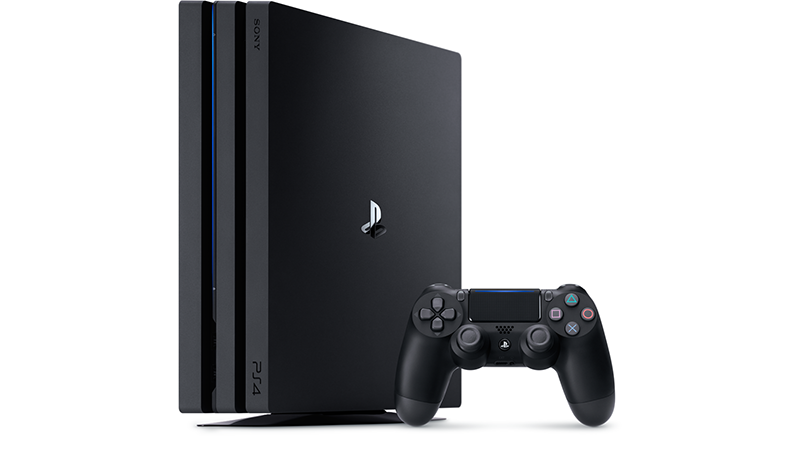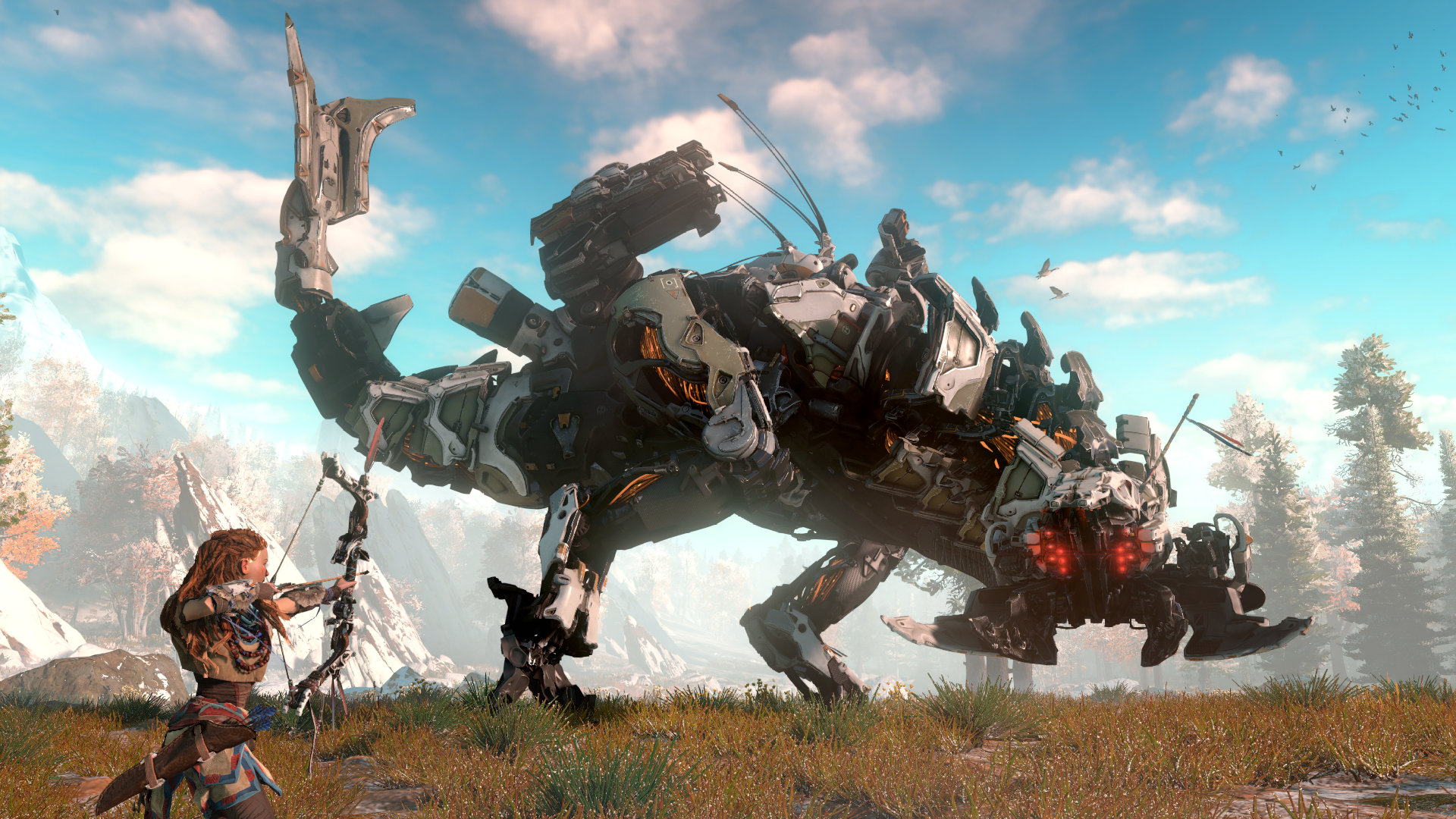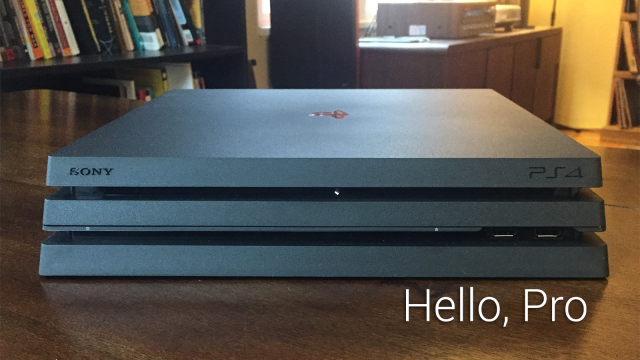Short version: The new PS4 Pro is a more powerful version of an already good console. We like the PS4 a lot, and the Pro doesn’t do anything to diminish that. However, it’s going to be a while before we know just what that added horsepower will be used for.
Sony’s new console is out this week. It will run you $559, which is $160 more than a standard PS4. The new console is physically larger than its predecessor, with a bigger hard drive and improved graphics processing power. It works with the same controller, uses the same operating system, and most importantly, plays all the same great games.
Sony sent PS4 Pros to me and Stephen Totilo last week, and since then we’ve been putting the new console through its paces. Here’s what we’ve found so far.
The Basics
The PS4 Pro is noticeably larger than the svelte PS4 or the extra-svelte PS4 Slim, but not by a ton. It looks more or less like if you horizontally cut a plain PS4 into thirds and layered one of the thirds onto a second PS4. On the back, it has the same connections as the regular PS4 with a bonus USB port next to the ethernet port. On the front, there are still two additional USB ports, along with an optical drive and relocated power and eject buttons.

On the right, an original PS4. On the left, the Pro. The footprint is basically the same, the Pro is just a little taller.
Inside, the PS4 Pro is sporting a faster GPU (graphics processing unit) than the base PS4, along with a marginally improved CPU. It also comes standard with a 1TB hard drive, doubling the plain PS4’s 500GB storage capacity. You can compare tech specs here.
In terms of accessories, the Pro comes with the same single earbud/microphone combo as the base PS4, as well as a slightly updated DualShock 4 controller.
Setup And Operation
PS4 Pro setup is pretty much the same as the original PS4. The new console uses a slightly different power cord, so you’ll finally have to stop using that PS3 plug you’ve been using for the last 12 years. Other than that, it’s about what you would expect: Plug the HDMI cable into your TV, plug the controller into the console. If you’re using a 4K TV you’ll have to adjust the output settings on the console and make sure your TV is setup to receive a 4K signal.
It’s easy to transfer your games from an existing PS4 via an ethernet cable — a utility automatically copies all the games, saves and game captures to the new machine. The first time I tried doing this, it told me I’d need 12 hours for the process to complete. I waited four hours before backing out and starting over. I started over, and it finished in 90 minutes. Go figure. Happily, my copy of PT made the jump from my old console to the new one. If you want, you can skip that step and just re-download any games you’ve bought digitally.

The new DualShock 4 controller has a thin light on the touchpad that matches the light-bar on the back. It’s perhaps a bit springier than my old DS4 but generally feels about the same.
The Pro seems to make about the same amount of noise as the original PS4 I bought in 2013, though the older console has gotten louder over the years. It’s nice to have an additional USB plug at the back of my console, which lets me keep my PSVR headset plugged in while freeing up the front two ports for my USB headphones and controller. However, I’ve found an odd bug in the operating system that switches my audio output from my optical cable to my USB headphones every time I put the console into rest mode. I’m not sure what the deal is, but it’s annoying, and it never happened on my original console.
We borrowed a 4K HDR TV from our colleagues at Gizmodo and set it up in the NY office to try out a few games on it. Setting the TV up proved to be more challenging than we had anticipated, though some of that could be specific to the TV we used. Once we got our settings dialled in, we found that games scaled up toward 4K resolution with no issue, but turning on HDR occasionally made the screen look dimmer or more washed-out. It wasn’t what we were expecting. Given how new the technology is and how difficult it is to test a variety of HDR 4K TVs, we’ll need more time to get a sense of how well it all works.
The 4K Future Hasn’t Quite Arrived
Sony’s messaging around the PS4 Pro has been almost exclusively focused on 4K and HDR. 4K refers to the looming new standard for TV resolution, which translates to 3840 × 2160 pixels, or 2160p. (Standard HDTVs run at 1920 x 1080, or 1080p, so a 4K TV with the same physical measurements would deliver a substantial increase in pixel density.) HDR is a separate technology that stands for High Dynamic Range, which allows a screen to display a richer colour palette. It is possible to buy a 4K TV that does not have HDR, and in fact many 4K TVs and monitors from the past few years don’t have it.
The PS4 Pro is capable of outputting games at 4K, though most of the time it’s actually upscaling the image from a lower resolution. Many games run with dynamic resolutions that sit closer to 1440p, though that will still look sharper on a 4K TV than a 1080p image would have. It’s similar to how the base PS4 (and the Xbox One) sometimes dip down to 900p or lower to keep things running smoothly.

Above: Next year’s PS4 exclusive Horizon: Zero Dawn
Both 4K and HDR are difficult to reproduce for readers, given that you’re likely viewing this article at sub-4k resolution on a non-HDR screen. It’s also difficult to talk about 4K because, well, no Kotaku staffers even own a 4K HDR TV. Mike Fahey has a couple of 4K monitors, but none of us has a TV with HDR. Hell, I don’t even play PC games at 4K, because even the most powerful graphics cards can only deliver smooth performance at 1440p. Given how cutting-edge most of us are when it comes to video game technology, the fact that none of us have 4K HDR TVs should tell you something about whether the world at large is ready to make the jump to 4K.
As much as Sony wants to push the PS4 Pro as a 4K console, the majority of people who own PS4s almost certainly don’t yet have 4K TVs. I considered buying one to use with the Pro and found that most recommended 4K HDR TVs go for $US2000 ($2646) or more. On top of that, I’d have to replace my surround-sound system, since it can only handle a 1080p video signal. Yikes.
I’m happy to blow a wad of cash on the next cool tech thing, but the price of 4K presents too much of a barrier for me. There’s also a relative paucity of streaming 4K content available — the majority of movies from services like Netflix aren’t in 4K, and Sony opted not to include a 4K Blu-Ray player in the Pro. There’s not enough there to justify the expense.
In a few years, it will probably be worth buying a 4K HDR TV. They will be cheap enough, and there’ll be enough stuff to watch on them. For now, Sony is pushing an expensive new technology that many of us aren’t quite ready for.
There’s Hope For Improved 1080p Games
Fortunately, the PS4 Pro can improve games in other ways than resolution and colour depth. Some of the PS4 Pro games we’ve been testing have also included expanded options for games running in 1080p, and it’s made me much more optimistic about the PS4 Pro in the short term.
Rise of the Tomb Raider probably has the best PS4 Pro update I’ve seen, and I’m hopeful we’ll get more like it in the coming months. If you load up the game on a Pro, you’ll find three “enhanced fidelity” options in the display menu: Higher Frame rate, Enriched Visuals or 4K.
4K obviously raises the resolution for a 4K screen. “Enriched Visuals” keeps the game running at 1080p, 30 frames per second (30fps) and adds some small visual improvements — added detail on foliage, improved shadows, that kind of thing. “Higher Frame rate” does just that: It keeps the visuals where they were in the base game while getting the frame rate much closer to a steady 60fps.
Here’s a video I made comparing the two 1080p settings, which gives a sense of how much smoother the game is with the higher frame rate setting turned on. Be sure to watch it in HD:
Not every game offers clear options like Rise of the Tomb Raider. Some games like Battlefield 1 and Titanfall 2 offer unmarked improvements like supersampling (rendering at a higher resolution then scaling down to 1080p for a sharper image) along with, according to one Titanfall 2 developer, a more stable frame rate.
Titanfall 2 does look sharper on a PS4 Pro, but unless I played both versions back to back, I probably wouldn’t notice the difference. Both BF1 and TF2 target 60fps on a regular PS4, but fall below that target when the action heats up. From what I could tell, neither game performed very differently on the PS4 Pro, even at 1080p. Titanfall 2 multiplayer sessions still get drops when a bunch of titans begin fighting, and Battlefield 1 still chugs when the action heats up or a lot of things are on fire. I’ve been particularly bummed that Battlefield 1 can’t always maintain 60fps on PS4 Pro, since frame rate drops in that game often get me killed.
Sony’s own games don’t get much meaningful improvement in 1080p. The Last of Us: Remastered already ran at 60fps on PS4 and now offers some improved HDR visuals, if you have a TV that supports it. (However, Digital Foundry has found that the higher resolution Pro version of TLOU runs at a notably less consistent frame rate than the 1080p version did on a standard PS4.) Stephen reports that while Ratchet & Clank looks nice scaled up to 4K, it already looked amazing in 1080p. Uncharted 4 stays at 30fps while adding higher-res visuals and HDR. Infamous: Second Son seems to run a bit more smoothly but still mostly sits at around 30fps. Bloodborne has gotten no upgrade at all, and my dream of playing that game at 60fps has quietly died in a corner.

I’m embedding this gif because it should probably be included in any article that talks about frame rate. Credit unknown.
(If you want in-depth technical analysis of games running on PS4 Pro, the reliable folks at Digital Foundry are doing a bunch of videos. Here’s Titanfall 2, and here’s Uncharted 4.)
Several PlayStation VR games are getting PS4 Pro updates, though I’ve had a hard time telling when a game has been upgraded versus when it hasn’t. For example, Thumper apparently runs at a solid 90fps now, though I thought that game was fine before. Batman: Arkham VR seems to run the same as it did — nice graphics, glitchy motion controller tracking.
Given that the PSVR headset is at a fixed resolution, it stands to reason that future PSVR games will look better and run more smoothly on the PS4 Pro. However, my biggest issue with PSVR is the fact that the PlayStation Camera and Move controllers aren’t quite up to the task of smoothly handling modern VR games. All the GPU power in the world can’t improve a lacklustre camera.
It’s heartening to see Crystal Dynamics take the opportunity to get Rise of the Tomb Raider running at a higher frame rate on the Pro in 1080p. The makers of Final Fantasy XV have also said they’re planning a December patch to get the game running closer to 1080p/60fps on PS4 Pro. Other big spring games like Dishonored 2 and Watch Dogs 2 will offer graphical improvements on the Pro but stay at 30fps. (You can see a full list of games with Pro support here.)
Regardless of Sony’s HDR-obsessed announcement event and marketing push, it seems the PS4 Pro will indeed lead to more console games running at 60fps. We’ll have to wait and see how many.
Sony’s Put The 4K Cart Before The 60fps Horse
If you had asked me a year ago what I would want from a mid-generation console update like the PS4 Pro, I would have immediately answered “higher frame rates”. I know I’m not alone in this — a reader poll we did back in 2014 suggested that more of you cared about frame rate than visual quality.
So on the one hand, we have higher resolution games with HDR and sharper visuals. On the other, 1080p games running closer to 60fps. The PS4 Pro makes both possible, yet Sony seems fixated on 4K.
I don’t want to buy a 4K TV for a variety of good reasons, and I’m annoyed to feel like Sony is pressuring me to get one before I’m ready. What’s more, three years after the PS4 and Xbox One came out, the console standard is still stuck at 30 frames per second. Microsoft’s beefy Project Scorpio console isn’t out until next spring, which gave Sony the first chance to change things with the PS4 Pro. Instead, they have decided to move the goalposts.
I’m relieved that game developers have demonstrated that they can still use the PS4 Pro to improve the performance of games in 1080p, should they choose to do so. There’s cause for hope along with some frustration. We’ll have to wait and see.
Should you get a PS4 Pro?
The PS4 Pro marks the dawn of a new, more complicated era for console gaming. But when it comes down to it, it’s really just a more powerful version of an already good video game console. Should you buy one? Depends.
If you don’t have a PS4 and want one, get a Pro. Maybe wait for a deal or something. It’s $160 more than a plain PS4 but it’s a more powerful system. It will support a 4K TV if you decide to get one, and in the meantime it will run some games better in 1080p.
If you already have a PS4 and don’t have a 4K TV, hold off. Sony has confirmed that the PS4 Pro won’t get any exclusives, which means that every game will have to run on both consoles. We’ll have a better idea of how many games will offer 1080p improvements in the months to come, and for now, the improvements just aren’t worth buying a whole new console.
If you own a 4K TV and really want to use it, sure, get a PS4 Pro. Even better if your TV has HDR. You already spent a ton of money on that massive screen in your living room, so you might as well spend some more to get a console that will take advantage of it.

Comments
27 responses to “Should You Buy A PS4 Pro?”
I’m stoked with mine, only complaint is the eject and power buttons feel cheap. Skyrim and The Last of Us look fantastic in native 4k. Definitely a better option than forking out for a PC.
I’m sorry about the flaming here, but did you not read the article? TLOU isn’t running at 4k at all. 1080p + scaling.
As for performance, its still lacklustre compared to a PC (we gauge performance as Ultra settings @ 60fps on resolution), rather than the method consoles use of upscale everything.
The Pro is a great console (I have mine already set up), but its exactly that, a console, and it doesn’t touch a PC even remotely in terms of visual fidelity.
Of course its lacklustre compared to PC but for the price compared to an equivalent PC its far better value.
The Last of Us does run at native 4k if you set it to 30fps, watch digital foundaries video. If you choose to play at 60 frames it plays in 1800p (my preferred option). Uncharted is upscaled to 4k, its not native. Skyrim is native 4k.
Did you not see the part on Digital Foundry’s coverage, where playing it @ 1800p saw a framerate WORSE than what the standard PS4 achieves @ 1080p? What’s even more disturbing is how the extra horsepower on PS4 Pro can’t even be used to achieve a perfectly locked 60 fps when forcing it to run @ 1080p – the performance is instead IDENTICAL to the original PS4, with dips in the exact same area. Disappointing doesn’t even begin to describe it.
Identical except all the extra effects (alpha transpareny etc) is what drags the frame rate down. Did you not see digital foundarys coverage in it.
OK, let me put it this way: I don’t care about resolutions above 1080p, I do care about a steady 60fps. This console doesn’t take what used to be the target framerate (@ 1080p) and make it a more stable experience. I don’t care if the drops only go down as far as the low 50’s in certain areas – I would rather there be NO drops at the expense of the better hardware. But instead they just jack up the resolution to 1800p and the framerate becomes worse than the experience on the base PS4 @ 1080p (even if it isn’t by a huge amount, it is still WORSE). And to the point of repeating myself: if you force the game to run in 1080p mode on the PS4 Pro, the one place I would expect it to LOCK the framerate in at 60fps, it fails to do that, too … instead we see performance which is identical to the base PS4 at that resolution. I certainly don’t care about 4K at 30fps. I wouldn’t get the PS4 Pro based on this example of ‘updating a game’. I’ve also heard reports that people playing Skyrim Remasted now have worse framerates than the base PS4 with no option to change the upscaling. They are taking away choice, and making the experience worse in some cases.
How much would a PC running games at native 4k with 60 frames cost? Not just Skyrim but newer titles
About $1k (presuming you already have peripherals and a case) and it will last longer and perform better and do more.
Be honest, it’d cost you around $2.5-$3k, However, its not an apples comparison either, as the PS4 can’t do it either.
No… it cost me less $1.2. But thanks for calling me a liar anyway.
To play 4k? At a stable 60fps maxed out? Yeah, your lying. Hell, my 1080 can’t do 4k well, and its 3/4 of the your said cost.
I’m sorry you have a pleb computer and don’t know how to source better priced parts 🙁
Do you even realize how big of a difference there is in graphics, PC maxed out vs ps4, in other words, PC with even medium settings should look better or similar to PS4, and maxed out it will blow it out of the water lol
Skyrim looks great, but colours in that engine seem a little washed out. Have a try of Shadows of Mordor if you have it. That looks stunning and has the same surreal “wow, things are just so damn sharp” feeling you get wandering around in Skyrim.
I keep being torn between being 4k tourist playing a game for 5 minutes to gawk at details, and then really wanting to play Dishonored 2.
The frame rate improvement I get with Battlefield 1 multiplayer just paid for the trade in residual. Pity EA are putting writers under NDA so they can’t talk about it. Maybe due to Xbox deal?
Pisses me off. I only just bought a PS4 last year.
So did I, traded my Ps4 in and paid $350. It doesn’t annoy me but fair enough, at least you’re only missing out on a graphics improvement
Heads up to those with a PS4 pro, PSVR and 4K HDR TV…
The PSVR pass-through box does not support HDR to the TV. This is a MAJOR hardware oversight by Sony. It means that if you want to get the most out of games in HDR, you must plug you PS4 pro directly into the TV, forcing you to switch cables every time you want to use VR – or buy a high end HDMI splitter box.
Very annoying. But first world problems I guess…
It is a pain.
For those who are curious, of what Ive seen HDR is supported by infamous FL (and second son prob), Deus Ex, Uncharted and World of Tanks (!). Yeah world of tanks, seriously.
HDR, the emperor’s new clothes of gaming tech.
inb4 a bunch of new games over the next couple of years run like horse shit on the original PS4.
Have they made any improvements to the shocking network speeds?
Yes. The network card is upgraded. The wi fi is definitely improved. It now allows a 5ghz option and is considerably faster.
https://www.reddit.com/r/PS4Pro/comments/5cc3pv/ps4_pro_wifi_significantly_faster_screenshots/
Not sure about wired or anything.
I think kramerwolf89 is talking about PSN, not the local network performance.
As for solving the local network speed issue, it was far easier (and cheaper) to wire it to a range extender which then handles the network link at both the 2.4 and 5ghz bands.
I wish they included more usb ports on the back of it.
Xbones looks better
Did anyone notice that the Pro came with OS version 3.7? Anyway I feel it’s great at what it’s doing and I still feel it’s OS and Apps still need a few updates for it to be really great.
Hi
I read up on 4K TV issues at launch because my Hisense had no picture only sound. This is an issue for a lot of LG/Vizio/Hisense TV’s so I was relieved to find I wasn’t alone.
There is a fix to this, being to wind back the HDCP to 1.4 when you put the PS4P in safe mode. This worked, but the TV had hideous frame rate @ 4K.
Hisense advised: Unfortunately, the K321 does not support HDR however there is a firmware update available to enable 4K devices.
Just FYI for any Hisense owners out there. Update the available firmware to enable PS4P @ 4K